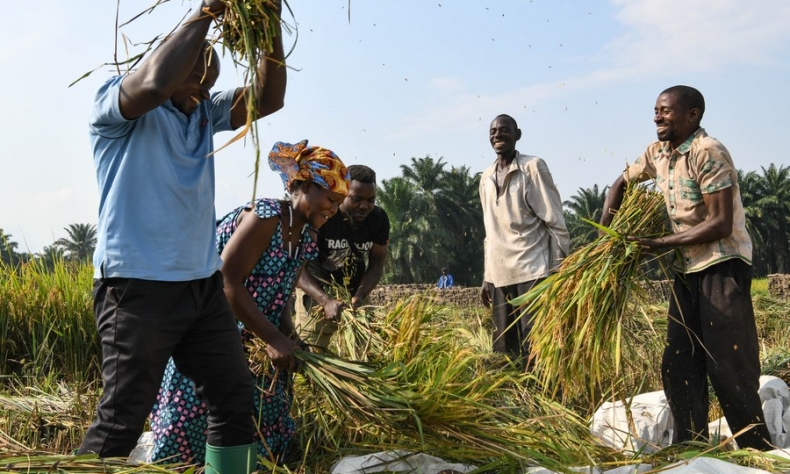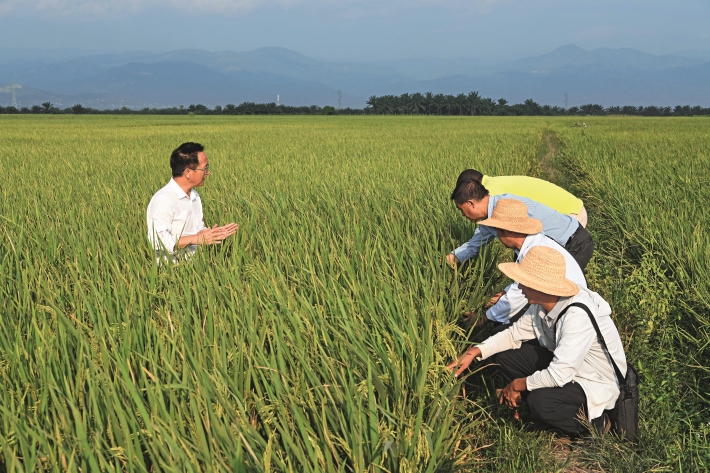Fields of Promise

Chinese hybrid rice technology boosts supply of staple food in Burundi.
Burundi and China enjoy close collaboration in a number of sectors, particularly agriculture. Among the major initiatives, the introduction of hybrid rice cultivation stands out as a flagship project. In 2018, the first demonstration village for hybrid rice cultivation was established in the commune of Gihanga in northwestern Burundi. In 2020, this initiative reached a crucial stage with the creation of the Burundi Agricultural Pilot Centre (APC), located in Gihanga in the province of Bubanza.
A total of 56 villages spread across 11 of Burundi’s 18 provinces have been selected for demonstration as of now. Yang Huade, head of the team of high-level Chinese agricultural experts supporting Burundi and a rice cultivation specialist who is also in charge of the APC, revealed that trials are currently underway in four provinces: the capital Gitega, the central province of Muramvya, and the northern provinces of Ngozi and Kayanza.
The varieties introduced in 2018 yielded more than 8 tonnes per hectare, a significant increase from the usual 6 tonnes.
An innovative centre
The APC has transformed hybrid rice cultivation in the region. According to Yang, the establishment of the centre marked a turning point, as the management of the centre was added to the responsibilities of the Chinese experts, in addition to their research work. Eight varieties of rice, resistant to disease and well adapted to the local climate, have been developed and released here. The centre also focuses on training local agricultural leaders.
Yang also identified some challenges, including limited space for testing and seed production. The area dedicated to seed production is just 8 hectares, which is insufficient to meet the growing demand. He advocates expanding this area to increase seed production. Furthermore, the centre faces budgetary constraints and a shortage of essential inputs such as zinc and certain herbicides.
Yang envisions large-scale production of rice for export, after local demand is met. This could become a major economic driver for Burundi by generating foreign currency. He views this as a special opportunity for Burundi, distinguishing the country from its African agricultural counterparts.

A widely endorsed project
Burundi’s President Evariste Ndayishimiye has expressed his gratitude for the assistance provided by China through the experts at the APC. Over a year ago, he witnessed a new method of growing hybrid rice during a visit to the commune of Mpanda. He also reaffirmed his commitment to innovations that would boost the country’s agricultural production.
This support was reiterated once again on 20 May 2023 at the hybrid rice harvest in Kizina in the commune of Gihanga, where production reached between 10 and 11 tonnes per hectare. The event was attended by Prime Minister Gervais Ndirakobuca and the Chinese Ambassador to Burundi Zhao Jiangping. Ndirakobuca praised the Chinese contribution to increasing agricultural production. The Ministry of Agriculture has recommended close collaboration with the centre’s experts.
Growing local interest
Samson Niyonzima and Alexis Girukwishaka, two rice growers from Gihanga, have enthusiastically adopted hybrid rice cultivation, attracted by its high profitability. Samson, a 26-year-old resident of Village 5, a demonstration site, reported impressive yields of 10 to 12 tonnes per hectare. He testified to the benefits of this crop: “Hybrid rice production has significantly increased our income. We are now better able to meet our daily needs. Many people in my village are now interested in growing this crop.”
Alexis Girukwishaka, a resident of Village 2, another demonstration site, is determined to continue growing hybrid rice, from which he is reaping significant benefits. “Thanks to the profits I’ve made, I’ve been able to build a solid house and launch other projects,” he said. An active member of a hybrid rice production cooperative, Alexis pointed out that the high cost of seed, which stands at 26,000 Burundian francs ($9.1) per kg, compared with just 7,700 Burundian francs ($2.7) for local seed, represents a significant challenge. He and his colleagues are requesting a reduction in prices, while encouraging the centre to increase seed production to make it more accessible.
“In the field of research, our understanding of certain technologies remains limited because we cannot reproduce them locally,” explained Privat Ndayihanzamaso, a researcher with the Burundi Institute of Agronomic Sciences. Since 2008, he has been focusing on plant diseases and pests, and has been studying rice cultivation from 2020 to 2023. Ndayihanzamaso is optimistic that local researchers will be able to master the production of hybrid rice seeds. “Seed production is the heart of real technology. Mastering this technology means you can develop your own varieties, which is not yet the case here. We have a fear of dependence in research, and remain cautious in this respect.”
He also mentioned a current trend saying that “at the moment, our partners are suggesting importing some of the seeds we use for production. They are proposing private imports from China. Our nation is attempting to cut foreign currency spending, but we are still insisting on this front. However, understanding the technique would be ideal.”
 Facebook
Facebook
 Twitter
Twitter
 Linkedin
Linkedin
 Google +
Google +










